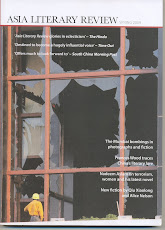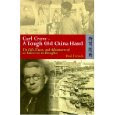
I’ve mentioned before that I’m currently in the process of editing Carl Crow’s Burma Road diaries from 1939. It’s a great project for me as Carl had planned to publish the diaries as a book but other projects, World War II and then sadly his death meant that he never got around to going back over them and editing them for publication. So now I’m doing it for him. The book is coming along fast – Crow had typed up and edited significant portions of it and fortunately had had time to get all his other notes typed up and dated so it’s far from an arduous task.
Crow undertook the trip in the spring of 1939 for Liberty magazine. By that time Shanghai was off limits to him courtesy of the Japanese so he had to fly from London to Rangoon. His ultimate destination was Chongqing, Chiang Kai-shek’s wartime capital, but to get there he had to head out of Rangoon to L ashio and the start of the Burma Road. From there is was a grueling trip by car up the road (in amongst the numerous supply convoys - left) through the Shan States as far as Kunming. Once in Kunming Crow flew to Chongqing spending two months there when it was the most heavily bombed city on earth. One reason I was keen to do the book was that while we have numerous reminiscences of the London Blitz and other major civilian bombing campaigns there is very little available on the Japanese ‘Blitz’ of Chongqing. While in the city Crow met all the major players – Hollington Tong, Madame Chiang, the Generalissimo and Zhou En-lai. The diaries finish with his departure through Indo-China to Hanoi, Saigon and then eventually back to London courtesy of Air France. Shortly afterwards the Japanese would invade Burma, close the Burma Road and also shut down Indo-China. These were the last months of Burma Road route to China till 1945.
ashio and the start of the Burma Road. From there is was a grueling trip by car up the road (in amongst the numerous supply convoys - left) through the Shan States as far as Kunming. Once in Kunming Crow flew to Chongqing spending two months there when it was the most heavily bombed city on earth. One reason I was keen to do the book was that while we have numerous reminiscences of the London Blitz and other major civilian bombing campaigns there is very little available on the Japanese ‘Blitz’ of Chongqing. While in the city Crow met all the major players – Hollington Tong, Madame Chiang, the Generalissimo and Zhou En-lai. The diaries finish with his departure through Indo-China to Hanoi, Saigon and then eventually back to London courtesy of Air France. Shortly afterwards the Japanese would invade Burma, close the Burma Road and also shut down Indo-China. These were the last months of Burma Road route to China till 1945.
Anyway, Rangoon. One thing that struck Crow about the city – still under British control when he visited in A pril 1939 and officially part of British India – was the European style and architecture of the city’s streets. The two postcards I’ve included here show two of the major thoroughfares of Rangoon – admittedly earlier than 1939 though they hadn’t essentially changed when Crow arrived. The Strand (above), with the famous Sarkie Brothers-owned Strand Hotel on the right, and Dalhousie Street (left) with a glorious European style building on the left, a Christian church on the right and a European-style tram running up the street.
pril 1939 and officially part of British India – was the European style and architecture of the city’s streets. The two postcards I’ve included here show two of the major thoroughfares of Rangoon – admittedly earlier than 1939 though they hadn’t essentially changed when Crow arrived. The Strand (above), with the famous Sarkie Brothers-owned Strand Hotel on the right, and Dalhousie Street (left) with a glorious European style building on the left, a Christian church on the right and a European-style tram running up the street.
If all goes to plan Carl Crow’s great previously unpublished work, ‘The Long Road Back to China: Along the Burma Road to China’s Wartime Capital in 1939’, should be published and available by September this year from Earnshaw Books- naturally I’ll keep you posted.
Crow undertook the trip in the spring of 1939 for Liberty magazine. By that time Shanghai was off limits to him courtesy of the Japanese so he had to fly from London to Rangoon. His ultimate destination was Chongqing, Chiang Kai-shek’s wartime capital, but to get there he had to head out of Rangoon to L
 ashio and the start of the Burma Road. From there is was a grueling trip by car up the road (in amongst the numerous supply convoys - left) through the Shan States as far as Kunming. Once in Kunming Crow flew to Chongqing spending two months there when it was the most heavily bombed city on earth. One reason I was keen to do the book was that while we have numerous reminiscences of the London Blitz and other major civilian bombing campaigns there is very little available on the Japanese ‘Blitz’ of Chongqing. While in the city Crow met all the major players – Hollington Tong, Madame Chiang, the Generalissimo and Zhou En-lai. The diaries finish with his departure through Indo-China to Hanoi, Saigon and then eventually back to London courtesy of Air France. Shortly afterwards the Japanese would invade Burma, close the Burma Road and also shut down Indo-China. These were the last months of Burma Road route to China till 1945.
ashio and the start of the Burma Road. From there is was a grueling trip by car up the road (in amongst the numerous supply convoys - left) through the Shan States as far as Kunming. Once in Kunming Crow flew to Chongqing spending two months there when it was the most heavily bombed city on earth. One reason I was keen to do the book was that while we have numerous reminiscences of the London Blitz and other major civilian bombing campaigns there is very little available on the Japanese ‘Blitz’ of Chongqing. While in the city Crow met all the major players – Hollington Tong, Madame Chiang, the Generalissimo and Zhou En-lai. The diaries finish with his departure through Indo-China to Hanoi, Saigon and then eventually back to London courtesy of Air France. Shortly afterwards the Japanese would invade Burma, close the Burma Road and also shut down Indo-China. These were the last months of Burma Road route to China till 1945.Anyway, Rangoon. One thing that struck Crow about the city – still under British control when he visited in A
 pril 1939 and officially part of British India – was the European style and architecture of the city’s streets. The two postcards I’ve included here show two of the major thoroughfares of Rangoon – admittedly earlier than 1939 though they hadn’t essentially changed when Crow arrived. The Strand (above), with the famous Sarkie Brothers-owned Strand Hotel on the right, and Dalhousie Street (left) with a glorious European style building on the left, a Christian church on the right and a European-style tram running up the street.
pril 1939 and officially part of British India – was the European style and architecture of the city’s streets. The two postcards I’ve included here show two of the major thoroughfares of Rangoon – admittedly earlier than 1939 though they hadn’t essentially changed when Crow arrived. The Strand (above), with the famous Sarkie Brothers-owned Strand Hotel on the right, and Dalhousie Street (left) with a glorious European style building on the left, a Christian church on the right and a European-style tram running up the street.If all goes to plan Carl Crow’s great previously unpublished work, ‘The Long Road Back to China: Along the Burma Road to China’s Wartime Capital in 1939’, should be published and available by September this year from Earnshaw Books- naturally I’ll keep you posted.








3 comments:
I came across this by chance, whilst searching for any news regarding my Mothers grandfather, Dr. CG Crow, who, Certainly in 1927was "I.M.D. Port health Officer. Rangoon.
My mother lived there till the japanese invasion and was air evac'd out to Calcutta with her mother, whilst her father (Crow also) had to walk through the marshland of what is now Bangladesh, to safety. Another interesting Crow journey in the region!
It’s great to see good information being shared. I really like this post. Thanks for the info.
There are many options why they aren't offering you credit history during those times: It's actually not suitable towards the talk. Ones runBuy D3 Gold or maybe approach could be section of a standard route the supervisor features determined; and there may be individuals from the mix. Your own tactic is often a spinoff associated with anything the actual manager may be talking about or perhaps a spinoff of your course conversation. They Buy GW2 Goldcan have got adequately neglected that the particular custom made seemed to be.
Post a Comment